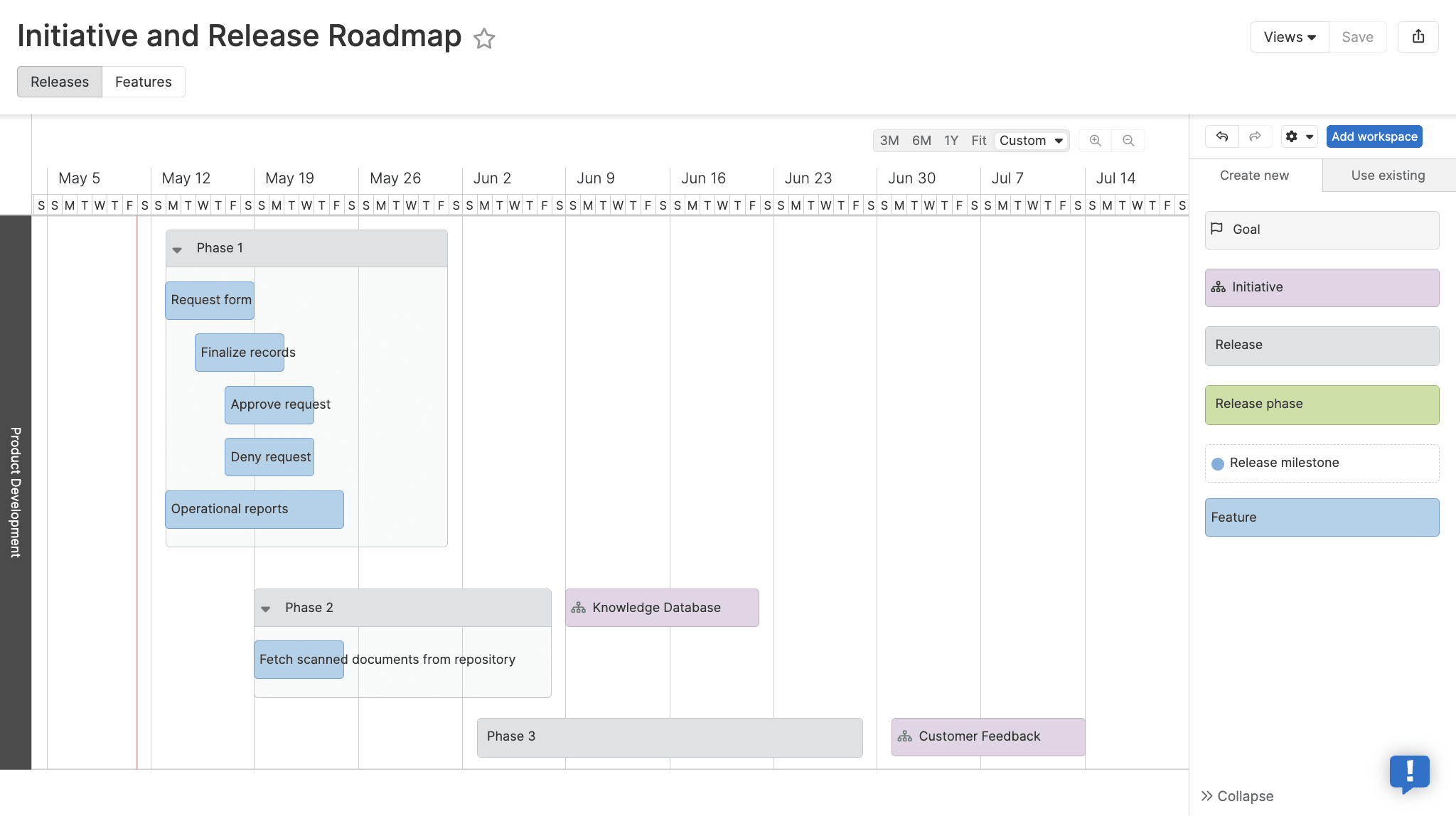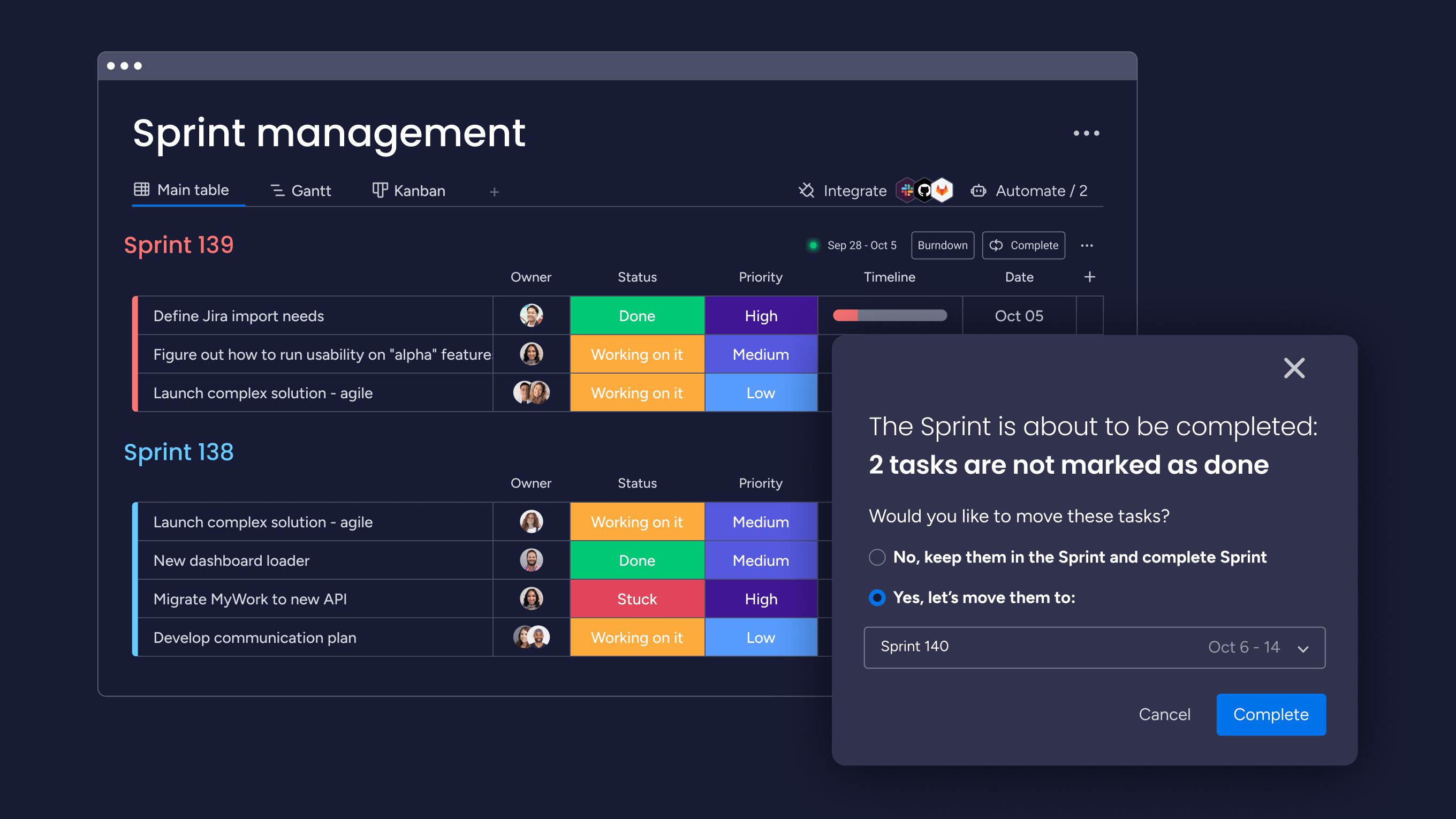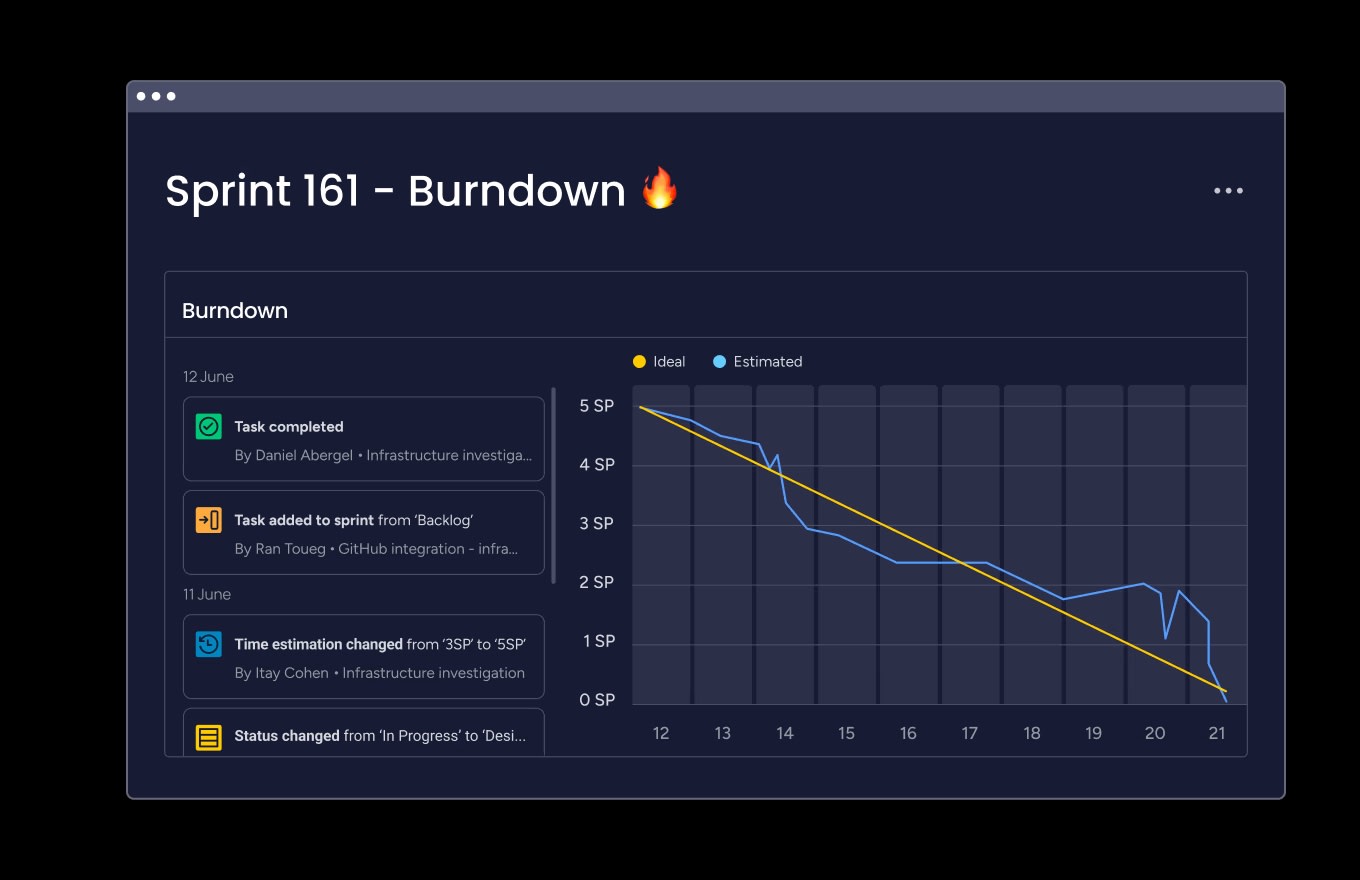Anyone who has worked in product development will be familiar with the Aha moment—that sudden feeling of insight or discovery that dawns on you when you have a great idea.
It’s no surprise then that Aha! is a software suite designed to help product management teams capture these winning ideas and transform them into customer solutions. But does it work, and is it the right fit for your business? Our detailed guide explores the key features, pros, and cons of Aha! product management. We’ll also explore how monday dev might be a better fit for your product team.
What is Aha!?
Aha! is a suite of product management tools developers can use to create products that resonate with their customers. The company was founded in 2013 in Menlo Park, California, by Dr. Chris Waters and Brian de Haaff, who later published “Lovability,” a book about the company’s philosophy and approach to business.
While roadmapping software was the original focus of Aha!, the company has recently launched standalone tools related to ideas, whiteboards, knowledge, and development to form the current Aha! software suite.
Aha!’s top features
Product builders may require the following features which are available in Aha!:
Idea management
Aha! provides a space to capture the lightbulb moments that influence your product’s direction. From here, you can prioritize top product concepts that resonate with your audience based on crowdsourced feedback from your focus groups, all stored in a single location. If that feels like searching for a needle in a haystack, Aha!’s AI tool can help you discover common themes and surface key use cases to save you some time.
Purpose-built whiteboards
Instead of relying on large pads of paper for brainstorming, Aha! provides built-in whiteboards to map out process flows, illustrate customer journeys, or design user experiences. Users can choose from 100+ templates to get started or switch to a blank canvas if they have something specific in mind.
Visual roadmaps
The next step is to turn your product ideas into a manageable roadmap for your teams to review and act on. Aha!’s visual roadmaps act as a high-level strategic plan from which users can pinpoint upcoming features, add milestones and timelines, and share meaningful data with their teams.
Integrations
Aha! integrates with 30+ key development applications, CRMs, and SSO solutions to keep information flowing between teams and software systems. For example, you might connect to a customer relationship management tool to ensure feedback captured in your CRM also displays in your ideation tool.

Pros of Aha! product management
Aha! offers several benefits for product developers, including the following.
Generates easy-to-share roadmaps
Top of the pro list is the ability to distribute roadmaps to key stakeholders to gain their feedback and insights. Sharing a roadmap internally is as simple as saving your preferred view, such as Gantt, and then sending it to your contributors. If you prefer to share roadmaps externally, it’s possible to save your roadmap as a web page and then send it as a link or embed it in an iframe. Alternatively, you might prefer to present your roadmap as a slide deck.

Provides strong customer service
Strong customer service is a common theme mentioned by Aha! users. The company responds to queries within two hours and offers an Ideas Portal where customers can log their suggestions to improve the platform.
Senior Product Designer Olena K elaborates,
“Technical Support is really fast and helpful. I have never experienced any pressure in terms of “marketing” promotion or upgrade or anything like this. Only pure help.”
Enables real-time collaborative editing
Successful products are rarely the work of a solopreneur—they take a team. One of Aha!’s most collaborative features is the ability to co-author, co-edit, or brainstorm a document in real-time. Users can configure editing access for a specific workspace or guest user or lock protected areas to avoid accidental changes.
Cons of Aha! product management
Some of the downsides we’ve mentioned below may not be a major issue for your product team but are always worth considering during your vendor research process:
Costs more than alternative tools
Although it’s possible to select from a pick-and-mix of features (for example, only purchasing the Whiteboard or Ideas solution), Aha!’s all-in-one Roadmap bundle is priced higher than many other options in the market. Some Aha! tools require a minimum of three users, so it might not be the best fit for small teams. Additionally, you may need to pay for several tools to get the range of features you require.
Suits product planning more than task-level management
With brainstorming and strategy features, Aha! is an excellent choice for product planning and ideation. However, other tools may be more suitable once you’re ready to execute development from a task level.
Requires a steep learning curve
Aha! has several features and opportunities to tailor the software to match your product team’s needs. Midmarket user Amit S explains why companies could benefit from plenty of budget and time set aside for training:
“Aha! can be complex and overwhelming for new users due to its extensive feature set and customization options. The learning curve may be steep, requiring time and effort to fully master the tool.”
To overcome this, Aha! Academy offers expert training and certification to maximize the use of the roadmapping tool. But priced at $2,390 per person, this is an investment some companies won’t want or be able to afford.
Aha! pricing options
Aha! offers a 30-day trial, after which the following price plans are available:
- Aha! Roadmaps: From $59/user/mo for the Premium version, $99/user/mo for Enterprise, and $149 for Enterprise+, on an annual plan. The flagship product includes access to Aha! Whiteboards, Knowledge, and Ideas.
- Aha! Whiteboards: From $9/user/mo for the Essentials package and $18 for the Advanced version on an annual plan.
- Aha! Knowledge: From $39/user/mo for the Essentials package and $59 for the Advanced version on an annual plan. A minimum of three paid users applies.
- Aha! Ideas: From $39/user/mo for the Essentials plan and $59/user/mo for Advanced on an annual plan. A minimum of three paid users applies.
- Aha! Develop: From $9/user/mo for the Essentials package and $18 for the Advanced version on an annual plan.
Is Aha! the right choice for your team?
Understanding how other development teams have experienced Aha! can determine if it’s the right choice for your team. G2’s software community is a useful way to dig deep into different use cases and user feedback to learn if it’s worth the extra dollars compared to other solutions.
Based on 280+ reviews, G2 users give Aha! an overall score of 4.3 out of 5. But what does this mean? The following scores (out of 10) tell a more revealing story about what Aha! is like to use:
- Ease of Use = 7.6
- Ease of Setup = 7.4
- Ease of Admin = 8.0
- Quality of Support = 9.1
Small business user Shivam A provides a positive review of the platform, particularly from a product management perspective.
“Aha! is undoubtedly an outstanding product management software program that performs exceptionally well in its extensive set of features and its ability to streamline the whole product lifecycle. Among the standout attributes is its strong strategy and road mapping abilities. Aha! enables users to outline their product vision, set proper objectives, and create visual roadmaps which align with their company goals. This permits clear conversation and alignment throughout teams, making certain everybody is working perfectly toward a common objective.”
However, other reviews note issues with user experience, particularly with navigating the tool.
“The platform could have been more user friendly. The UI is very confusing and it takes a lot of tries to find what you are looking for. You definitely need hands-on practice on the product to be able to derive value out of it,” said one verified user.
Taking into account the expensive pricing, the potential problems with user experience, and focus on planning more than execution, it might be worth exploring other platforms, such as monday dev.
How does monday dev compare to Aha!?
Aha! offers many strategic planning features that may suit your product management needs. But if you’re looking for a superior solution that covers your entire product lifecycle from ideation and strategy to launch and beyond, then monday dev could be a better, and more cost-effective fit. Our flexible end-to-end product development platform solution delivers impact at every stage. Here are the top features your teams will love:
Sprint management
While Aha! Develop users can create simple sprints, monday dev has a full-featured approach to sprint management. From sprint planning, daily stand-ups, and retro and sprint reviews, it’s easy to manage your entire lifecycle from a single location and develop better products faster.

Burndown charts
monday dev offers rich burndown charts that create a clear visual display of any potential problems or bottlenecks in your processes. While burndown charts are available in Aha! for Advanced plan users, they’re a standard feature in monday dev, enabling every team member to compare the actual remaining effort of their sprints with the ideal progress.

Integrations
While Aha! integrates with 30+ tools, monday dev excels by offering seamless integrations with 200+ other tools, such as Figma, GitHub, GitLab, Jira, Slack, and Microsoft Teams to keep your team’s work in one place. Using our no-code recipes, it only takes a few simple clicks to set up each integration and get your data moving from one platform to another.

Automation
Aha! and monday dev both use triggers, conditions, and actions to automate repetitive tasks. For example, you might set up an automation to send a product team member an email when an idea in a certain category becomes popular. As monday dev integrates with a vast number of communication, development, project management, CRM, and email platforms, this skyrockets the volume of potential automations you can set up, compared to Aha!

There’s no need to take our word for it; G2’s user community scores monday dev 4.7 out of 5, based on almost 1,400 reviews. That’s 0.4 higher than Aha! Digging deeper, our platform also scores the following out of 10:
- 9.1 for Ease of Use (1.5 higher than Aha!)
- 9.0 for Ease of Setup (1.6 higher than Aha!)
- 9.2 for Ease of Admin (1.2 higher than Aha!)
- 9.2 for Quality of Support (0.1 higher than Aha!)
One verified user describes their experience of using monday dev:
“I like best that it is effortless to use, and provides features like creating nested roadmaps, which helps me manage the vision of my entire product. I can easily manage the whole lifecycle of my product, starting from development, marketing, project management, CRM, and other business operations. I personally use it to create, yearly and quarterly roadmaps. Most of all, during monthly planning, I can easily collaborate and share my dashboard with my entire team.”
Ready to improve your own product development cycles? Take a free trial of monday dev today.
FAQs
Is Aha! an Agile tool?
Aha! offers some elements that align with Agile principles, such as sprint management and burndown charts. However, these are only available in certain price plans.
What is the difference between Aha! and Jira?
Both Aha! and Jira are product management tools, but they have different focuses. Aha! is primarily used for strategy and roadmap planning, while Jira is more geared towards task-level Agile project management.
Can Aha! be used for project management?
While Aha! does have some project management features, it's stronger for planning than execution. You might prefer to integrate it with another tool or use an all-in-one product management platform like monday dev to plan and manage your products from end to end.
 Get started
Get started 
